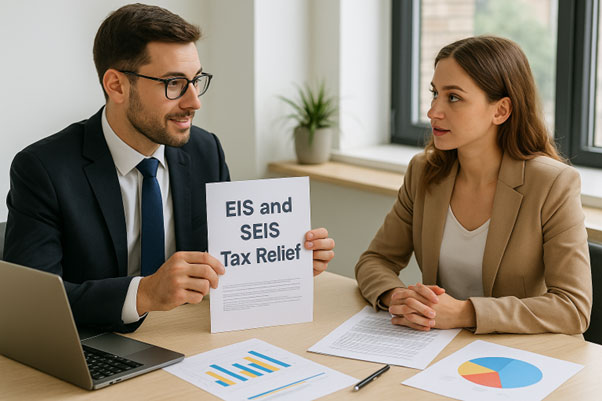-
News
-
Blog
-
Archive

Raising investment for your startup can be challenging—especially when potential investors are looking for ways to reduce their tax bill while backing high-growth opportunities. That's where EIS and SEIS tax relief schemes come in.
These government-backed schemes offer powerful incentives to investors, but choosing between the Enterprise Investment Scheme (EIS) and the Seed Enterprise Investment Scheme (SEIS) depends on where your company is in its growth journey.
In this article, we explain the key differences between EIS and SEIS, compare their benefits, and help you decide which scheme suits your business best.
What Are EIS and SEIS?
EIS (Enterprise Investment Scheme) and SEIS (Seed Enterprise Investment Scheme) are HMRC-approved tax relief schemes designed to encourage investment in early-stage UK companies.
- SEIS targets very early-stage startups (think MVP and pre-revenue).
- EIS is aimed at slightly more established businesses with growth plans.
Both allow investors to reduce their tax liabilities—but with different rules, limits, and investor protections.
Key Differences at a Glance
Feature |
SEIS |
EIS |
Company Age Limit |
< 2 years |
< 7 years |
Max Investment Per Investor |
£200,000 per year |
£1 million per year (£2m if KIC) |
Tax Relief on Income Tax |
50% |
30% |
Capital Gains Tax Relief |
50% CGT reinvestment relief |
CGT deferral relief |
Shares Must Be Held For |
3 years |
3 years |
Total Amount Company Can Raise |
£250,000 |
£12 million (£5m per year) |
When Should You Use SEIS?
SEIS is ideal if:
- You've just launched or are pre-revenue
- You need your first round of seed capital
- You're raising less than £250,000
- You want to attract early investors by offering generous 50% tax relief
Use case example: A tech startup with a prototype and a small team raising £150,000 to test the market.
When Should You Use EIS?
EIS is better suited if:
- Your startup is a bit more established
- You're post-revenue or scaling operations
- You want to raise larger sums (up to £12m lifetime)
- Your investors are looking for longer-term gains and CGT deferral
Use case example: A SaaS platform that has paying customers and is raising £1m to expand sales and marketing.
Can You Use Both?
Yes—many startups use SEIS first and EIS later.
This strategy allows you to raise your early £250,000 under SEIS (maximising the 50% tax relief), then raise further funding under EIS once your business grows.
YRF Accountants can help you structure your fundraising so you don't miss out on either relief.
How to Qualify
Your company must meet specific HMRC eligibility rules for both SEIS and EIS. These include:
- Trading status (most trades qualify, but some are excluded)
- UK-based and not listed on a stock exchange
- Not controlled by another company
- Spending the funds for genuine growth, not working capital alone
For a smooth process, many startups apply for Advance Assurance from HMRC before raising funds. This reassures investors you're eligible.
Need help with Advance Assurance? Talk to us about SEIS/EIS compliance services.
How YRF Accountants Can Help
We support UK startups with:
- Structuring SEIS/EIS rounds correctly
- Preparing and submitting Advance Assurance applications
- Filing post-investment compliance statements (SEIS1/EIS1, SEIS3/EIS3)
- Advising on share structure, investment caps, and investor eligibility
“Our goal is to help startups unlock funding and make investor tax relief hassle-free.” – Yasir, Founder at YRF Accountants
Ready to Use EIS or SEIS?
Choosing the right scheme could make the difference between a successful round and missed investment.
Book a consultation to get expert support:
https://calendly.com/yrfaccountants-info/30min